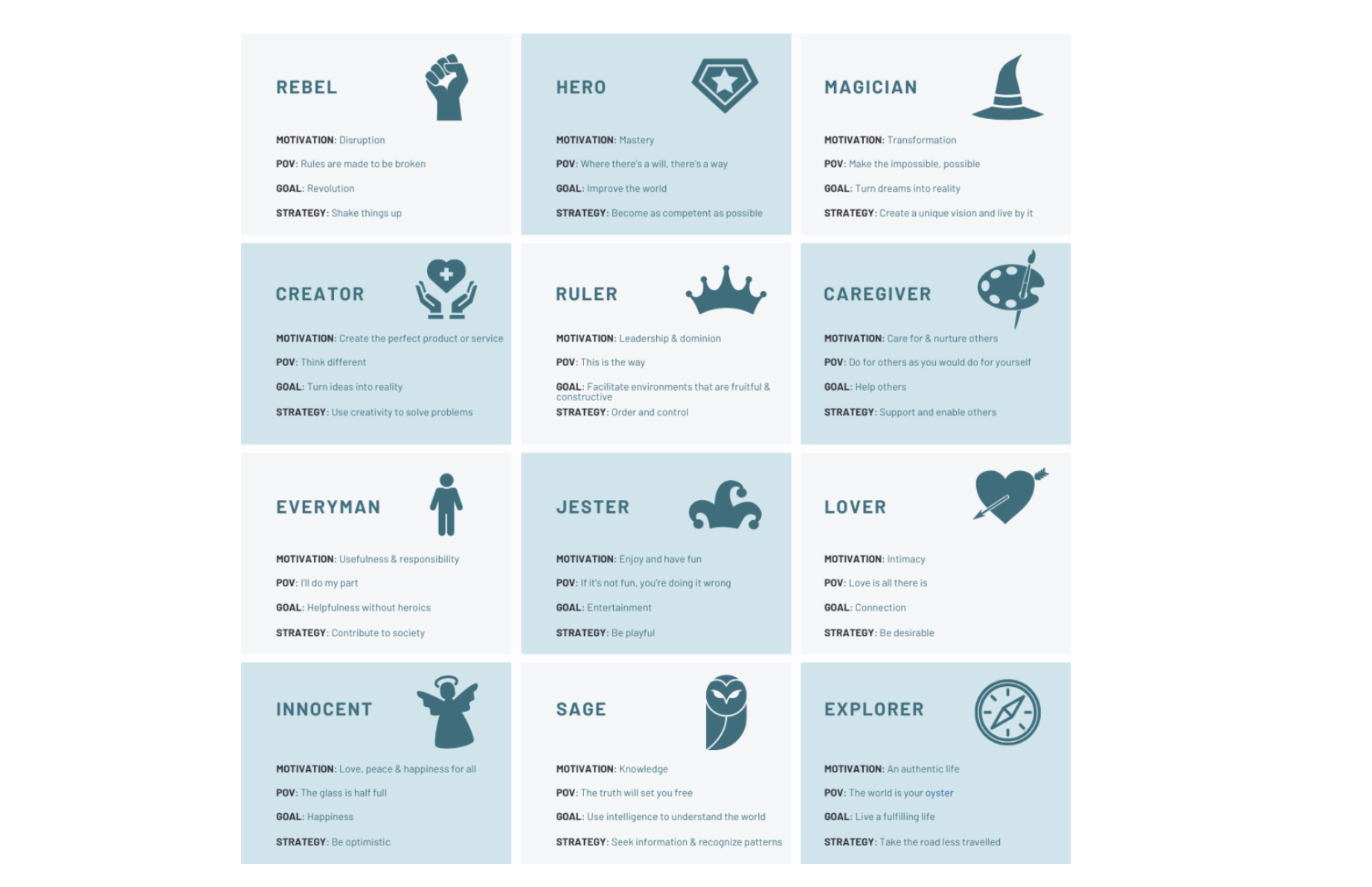Some people choose oat milk because they like the taste.
Others choose it because it signals something.
Same with trail shoes. Ergonomic desk chairs. Or $118 leggings. (You know the ones.)
We like to think we’re making rational decisions. But more often than not, we’re expressing something—about who we are, or who we want to be seen as.
The most memorable brands don’t just sell a product.
They sell identity.
They take on a role in the story of you.
The challenger. The protector. The innovator. The guide.
That role is your brand’s archetype.
Originally coined by psychologist Carl Jung, archetypes are universal character types that show up across cultures, stories, and experiences.
And when brands align with one clearly, everything clicks: the voice, the message, the design, the feeling.
But when they don’t?
The brand feels scattered. Generic. Or just… forgettable.
Archetypes give the brand a distinct character to play, and make your message instantly more human and emotionally sticky.
This matters because customers aren't just evaluating what you do. They’re deciding how it makes them feel, what it says about them, and whether it fits into the version of themselves they’re building.
Archetypes help you meet them at that emotional level, without losing strategic clarity.
Three Ways to Activate Your Brand’s Archetype
When your brand consistently shows up as the same “character,” people know what to expect, and how to remember you.
You don’t have to box yourself into one rigid persona. Some brands blend two archetypes depending on context. What matters is choosing a core role AND using it intentionally.
Here’s how to find (and use) yours.👇
1. Pick a Primary Archetype
Start by identifying the dominant role your brand plays.
Each of the 12 archetypes reflects a core human drive—freedom, safety, mastery, connection, etc.
When you pick the right one, it anchors everything; your message, your behavior, your voice.
Some quick examples:
- The Creator → Innovation is the product. (Notion, Adobe)
- The Hero → Overcomes the odds. (Nike, Peloton)
- The Caregiver → Puts protection first. (Allstate, Johnson & Johnson)
- The Rebel → Disruption. Rule Breaker. (Liquid Death, Harley-Davidson)
Your archetype isn’t a tagline or a campaign. It’s the role your brand plays in your buyer’s story.
Check out the archetypes below.

Example: Patagonia plays the role of the Explorer. It invites you to challenge norms, protect the planet, and push into the wild. And it reinforces that identity—visually, verbally, behaviorally—everywhere you look.
2. Use Archetypes to Differentiate in a Crowded Category
If you sell something that’s hard to explain or easy to replicate, personality becomes your shortcut to memorability.
Most B2B brands rely on functional language:
“Scalable.” “Secure.” “Next-gen.”
An archetype reframes the story.
Let’s say you’re in fintech. Most brands default to The Sage (smart, expert-led).
But what if you picked The Creator instead?
Suddenly, your product isn’t just accurate—it’s imaginative. You solve the same problems, but your voice, visuals, and value proposition feel different.
Sage-style: “Advanced analytics for smarter financial decisions.”
Creator-style: “Build the future of finance—your way.”
It’s still fintech. Still solving the same problem.
But the Creator speaks to vision and originality, not just intellect.
3. Make Your Archetype Tangible in the Work
An archetype isn’t just for the brand book.
It should shape the way your team makes decisions, creates content, writes copy, and shows up in moments that matter.
Ask yourself (and your team):
→ Does this sound like something we would say OR just something anyone could say?
→ Are we reinforcing the same emotional role in our content, copy, and customer experience?
→ If our name were removed, would someone still recognize the voice as ours?
Your archetype should act like a magnetic north; something that quietly pulls everything into alignment. Not in a rigid, scripted way. But in a way that feels recognizable, no matter the channel.
Because when people feel your role before they even finish reading your sentence, you’ve moved from marketing to meaning.
Let’s Walk It Through
Here’s how an archetype *actually shows up—*in the words, choices, and moments your audience experiences.
(This is just a fictional example for demonstration purposes.)
VitaPath is a digital health platform designed to support patients managing chronic illnesses.
Most competitors position themselves as The Sage: packed with clinical data, AI diagnostics, and smart charts.
But VitaPath leans into The Caregiver.
Their focus is making patients feel seen, supported, and safe.
That choice reshapes everything:
→ Their onboarding flow doesn’t push features, it asks how you’re feeling.
→ Their app isn’t just about tracking symptoms; it checks in with encouragement and reminders from real nurses.
→ Their homepage headline: “We’re here for more than your symptoms.”
Same tools. Same tech. But the message feels like a caring partner instead of a dashboard on a screen.
The homepage below doesn’t lead with product specs or medical terminology.
It opens with a feeling: calmness, warmth, and care. ↓

Action Step: Put Your Archetype to Work
Grab a sticky note—or open a blank doc—and try this:
1..Pick your primary archetype.
Which one fits the role your brand plays in your audience’s life? (Look beyond your product. Think about the emotional role your brand plays when you're doing your best work.)
2. Write ONE sentence your brand would say, in character.
Example: If you’re The Rebel, what’s your rally cry? If you’re The Caregiver, what comfort do you offer?
3. Pressure-check it against your customer’s reality.
Ask: Does this archetype align with what your best customers actually value you for?
Not what you want to be, but what people trust you to deliver.
If there’s a gap between how you show up and how they experience you, that’s your signal to realign.
Bonus GPT Prompt:
Use this to sharpen how your archetype actually shows up in your messaging.
Prompt:
Act as a messaging strategist.
I’m going to describe the archetype I believe our brand aligns with, along with a short description of what we do.
Please help me:
- Identify how this archetype typically sounds (tone, word choice, emotional energy)
- Suggest 3 brand phrases or sentences in the archetype’s voice that we could use on a homepage, deck, or headline
- Call out any mismatch between what the archetype promises emotionally and what our description implies
- Suggest one adjustment to better align how we show up with the archetype’s core energy
Here’s our archetype: [Insert archetype]
Here’s what we do: [Insert short description]
Your Tiny Challenge:
Write one sentence that proves your archetype (without saying what it is).
Not a label. Not a tagline. Just a line your brand would say if it fully lived that role.
Here’s how to get there:
→ Think about what your audience needs to hear most.
→ Say it the way your archetype would say it.
→ Make it something you’d actually use.




















